

Jonathan Davies
20 mins read
Start building your digital home with Happeo
Request a demo"Traditional intranets are dead" says Gartner. And we're inclined to agree.
For a start:
- They’re hard to access
- They’re not personalized
- They’re blocking digital transformation
In short, they’re a turn-off for employees, and in reality, they’re little more than a directory of jump links to other resources.
On the other hand, modern intranets are a different ball game altogether, bringing greater employee satisfaction.
In this guide, we’ll cover how the modern intranet can solve those “traditional” issues and how your company can benefit.
Let’s start with a quick definition…
What is a modern intranet?
A modern intranet is the latest version of the corporate intranet. It’s designed for today’s fast-paced, collaborative workforce who work from various locations throughout the day.
For most employees, the intranet is the first app they see when they fire up their web browser or switch on their mobile phone in the morning – it’s the gateway to their digital workplace.
A modern intranet typically ditches the traditional hierarchical information structure for a personalized one and integrates systems and services rather than linking out to them.
It enables employees to perform various tasks, such as:
- Accessing company announcements via their web browser or mobile phone
- Reading and engaging with company news via a personalized homepage and timeline
- Accessing integrated applications, information, and tools they need for work
- Collaborating on projects and communicating with colleagues
- Finding resources and documents, like visual org charts or onboarding docs
Modern intranets are the entry point to your digital workplace
The term "digital workplace" describes all of the available tools and platforms that an employee can access for their work.
And the modern intranet is usually the gateway to that digital workplace.
Besides an intranet, a digital workplace also includes other platforms, like:
- Collaboration apps, such as email or team chat
- Virtual networking and conference tools
- Service tools, such as a travel expense portal
- Core business (ERP) applications, like SAP
Modern intranet platforms can either link to these digital workplace tools or provide "microservices" by integrating with them directly.
They also have to provide a positive employee experience, known as the Digital Employee Experience (DEX). Nowadays, employees consume information in various places, using different devices, such as:
- In the office on a web browser
- On the road on a smartphone
- At home in the evening
So, as the entry point to your digital workplace, the modern intranet has to adapt to each situation to provide a positive employee experience.
Then and now: The evolution of the modern intranet
The intranet has evolved from its most basic static form of internal pages that one person controlled to a deeply integrated solution with more communication and collaboration capabilities that combine the benefits of each iteration.
Here’s how it evolved from an internal website to an employee portal and, finally, a modern (social) intranet:
Internal website
The internal website typically used the same technology as the external website since IT departments already had the license and the in-house (or agency partner) skills to maintain it.
Requirements of the internal website:
- Simple content pages
- Links and templates to organize knowledge
- Basic news functionality
Limitations of the internal website:
- Only suitable for one-way information distribution, not interactive
- Not possible or highly complex to integrate external services
- Almost impossible to personalize content
- Challenging for most editors to maintain the content
- Remained relatively static post-implementation
- Mobile optimization was not a requirement at the time
Employee portal
The employee portal technology stack changed significantly from the internal website. It used specific software to integrate tools and processes rather than creating and maintaining static content pages.
Requirements of the employee portal:
- Integrate Employee Self Services (ESS) from other applications, such as an HR system, directly into the intranet
- Enable employees to complete limited tasks related to their job and workplace using ESS on the intranet.
Limitations of the employee portal:
- Required elaborate and expensive software that could handle content well
- Only suitable for one-way information distribution, not interactive
- Integration of external services was possible but still expensive
- Challenging and frustrating for editors to use, even after training
- Not optimized for mobile devices
The modern (social) intranet
The modern intranet emphasizes social networking, user-generated content, and cloud computing from the Web 2.0 era. Employee participation and interaction are now paramount.
Requirements of the modern intranet:
- Interactive applications such as wikis, blogs, and social networks
- User interaction and feedback options (e.g. comments and likes) on various topics
- Collaboration on projects and in communities
Limitations of the modern intranet:
- Early social intranets were basic blog or wiki tools.
- Later versions merged into a "suite" known as the "Enterprise Social Network (ESN)" or the "Social Intranet".
What to look for in a modern intranet solution
When deciding on a modern intranet solution, you’ll want to ensure it has all the essential features and any specific functionality for your organization.
Some of the core features include:
- Content management
- Advanced search
- Mobile app
- Collaboration spaces
- Workspace integrations
- Reporting and analytics
Let’s dive deeper into all of the features…

“The biggest, most powerful thing I can do with analytics is knowing what's working, whom we’re talking to, and whom we're not reaching. Now I can see engagement, and I can see gaps. I can use tools to fix those gaps and then see if I'm on track with it, thanks to Analytics.”
Michelle Chessler
Vice President of Corporate Marketing
Fast implementation
Businesses want to design and implement their modern intranet quickly. Nowadays, most companies prefer rapid cloud-based implementations rather than on-premises solutions.
According to the Nielsen Norman Group, the average time of creating an intranet decreased significantly from just over 6 years in 2011 to 14 months in 2018:
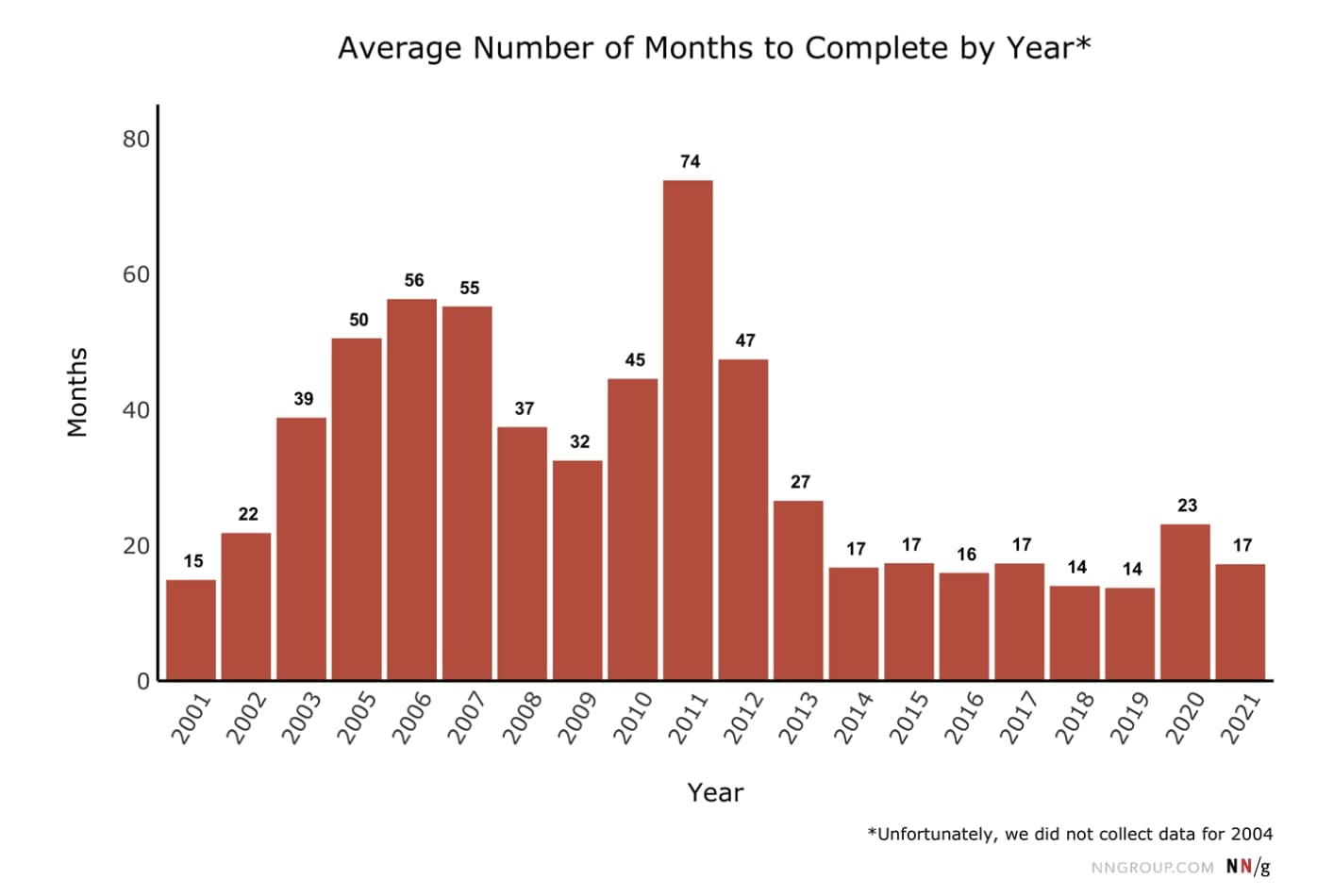
The latest agile technology and development methodologies mean companies can implement most intranets between 1-2 years.
However, Happeo’s average launch time is only 6-8 weeks. Since the app is so user-friendly, everyone can create content quickly. And with unlimited contributors, you can implement your intranet fast.
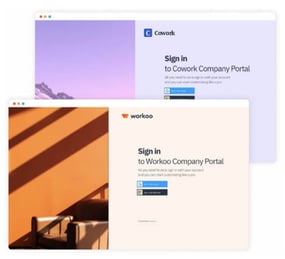
Image: Happeo customers can launch a modern intranet in weeks, not years.
Intuitive experience
Companies want their modern intranets to be accessible and user-friendly, which means they want a similar intuitive user experience (UX) to consumer applications.
Federated Search
The federated search function enables employees to easily search through all your company information, across all your applications, from one single search bar. It’s a vastly improved search experience. Previously, employees had to move from one system to another, looking for snippets of information.
A McKinsey study found that workers spend 19% of their time searching for and gathering information. So a federated search with its single interface to find everything they need boosts employee productivity.
Happeo’s powerful Universal Search and Federated Search lets employees use one search bar to find content in the platform, email, Google Drive, OneDrive, and third-party apps like Slack, Jira, and Confluence.
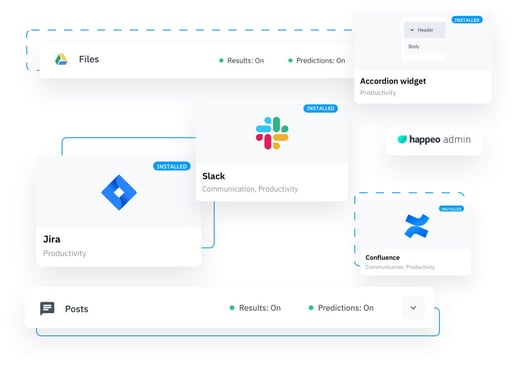
Personalized pages and timelines
A modern intranet should personalize the information, links, and applications that each user can access. After all, what’s relevant to one employee may be irrelevant to another.
Plus, personalized intranet experiences will motivate employees to come back and use it actively.
Happeo’s personalized timeline allows employees to eliminate distractions and only see the important news for them. And with the personalized homepage feature, you can create a custom company homepage with relevant dynamic content for each user, role, and function.
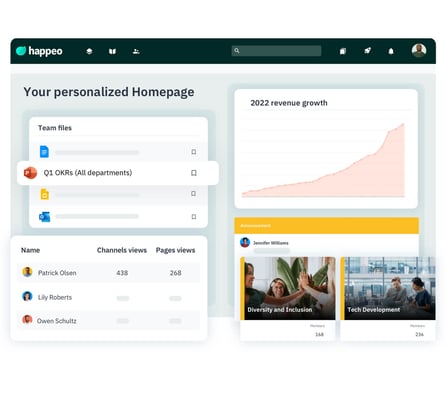
Image: Creating a personalized intranet homepage in Happeo.
Using its drag-and-drop builder and dynamic widgets, anyone can create a personalized page without a single line of code.
Content management
An intranet content management system (CMS) is essential for many businesses.
It allows employees to create, publish, modify, share, and archive digital content on one platform. Everyone can post professional-looking documents with embedded images, graphs, and videos to keep content fresh.
An intranet CMS lets everyone in an organization participate in information management, improves Internal Communication, and boosts productivity.
With Happeo’s Articles, everyone can contribute to your company’s knowledge base. It’s as simple as styling a document.
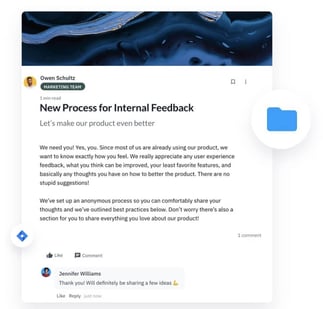
Image: Happeo’s intranet CMS makes it easy for any employee to contribute to the company’s internal knowledge base.
People profiles and directories
People profiles and directories are two essential features to look for in a modern intranet.
People profiles make it easier:
- For new employees to become acquainted with the company when onboarding
- For employees to learn as much about their colleagues as possible
- For people to get to know each other on a more personal level
- For management to find information about an employee's activities in the virtual workspace.
People directories make it easier:
- For employees to find and access colleagues’ contact information, including name, job title, email, and phone number, in one location.
- For people to find details on an individual’s team, skills, activities, and experience.
- For colleagues to share personal information, such as background, interests, and hobbies.
Collaborative features
A key feature of the modern (social) intranet is collaboration.
With a social intranet, employees can access all company resources, collaborate with colleagues on projects, share ideas, contribute to discussions, and have fun with their colleagues.
Happeo’s Channels feature lets people:
- Post and share messages, articles, photos, and videos
- Comment and like posts and get feedback
- Connect with colleagues and share personal stories
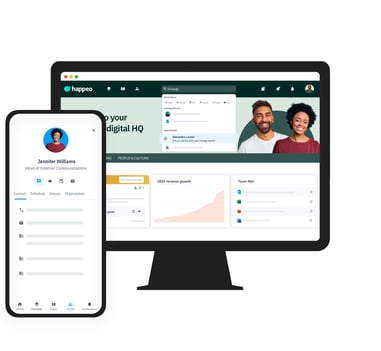
Image: Happeo is a modern intranet that makes it easy for employees to collaborate from any device.
Mobile access
Nowadays, people spend as much time on their smartphones and tablets as on their laptops.
A study by FierceMobileIT revealed that 71% of employees spend over two hours a week accessing company information on mobile.
So, a modern intranet needs mobile access, and preferably native iOS and Android apps, to keep people engaged.
Happeo’s secure mobile app has an intuitive interface and immediate push notifications to keep everyone connected on the go.
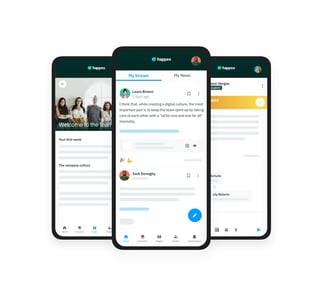
Workspace integrations
A modern intranet should integrate with your existing workspace collaboration tools like Google Workspace (Drive, Gmail, Docs, Meet, Chat, Search, Groups, and Calendar) or Microsoft 365 (OneDrive, Word, Excel, Outlook, Teams, and Sharepoint).
Finding files, searching for colleagues, managing documents, communicating, socializing, or even scheduling meetings and video calls – all within a single platform – makes your organization more efficient.
Happeo’s integrations with Google Workspace and Microsoft 365 keep files 100% synced with content in Google Drive or OneDrive, so you’ll never have duplicate versions. Plus, you can embed and edit Docs, Sheets, and Slides without leaving the intranet.
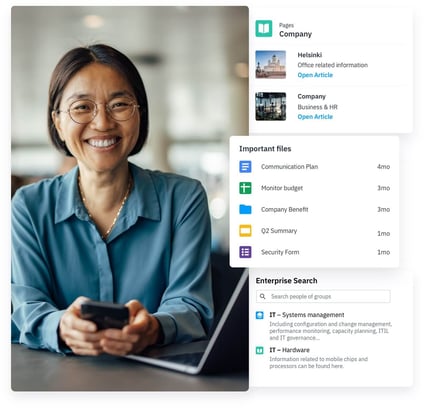
Image: Modern intranets enable users to view and edit files from third-party apps and workspaces from directly inside the platform.
User and Content Analytics
User and content analytics help you measure the success of your intranet and Internal Communication strategy. For instance, you can see what employees want to talk about, which content gets the most views, and which posts get the most interaction.
Happeo’s Advanced Analytics lets you optimize your content and searches so that you can create more engaging posts. For example, you can monitor:
- Page engagement: Check which pages get read the most
- Channel engagement: Get an overview of the most active and popular channels
- Post Analytics: See how well each post performs, so content creators learn what resonates
- Influencer Analytics: Discover who your employee ambassadors are and monitor their impact on the business
- Search Analytics: Discover the most searched keywords, total searches, unique search users, the average time to find results, and success and failure percentages
- Data download: Share a comprehensive CSV export with colleagues

Image: View page, post, channel, and user engagement metrics.
Customizations
Last but not least, you’ll want a modern intranet that you can customize. Every business has its own requirements. So while it’s fine to use an “off-the-shelf” solution, you need software that you can modify to meet your requirements.
Happeo offers this exact type of customization.
Its Full Branding Add-on allows you to choose colors, fonts, icons, logos, and a custom URL to promote a consistent brand identity. You can easily create a custom company homepage with relevant dynamic content for each user, role, and function.
Happeo’s custom intranet widgets give you total flexibility when building your pages. For example, you could use a custom widget to:
- Embed your HR solution, such as Workday or Bamboo HR
- Add project management tasks from Asana or Trello
- Bring the latest CRM information to hand
- Place an IT ticketing system, such as Jira
At the end of the day, employees are more likely to use their intranet when it looks custom-made for their company.
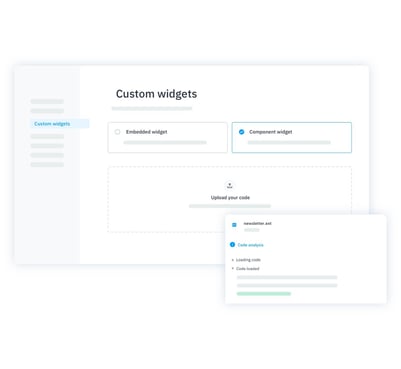
Image: Happeo makes it easy for companies to customize the intranet user experience.
Benefits of a modern intranet:
A modern intranet can help your organization to:
- Share knowledge
- Collaborate better
- Boost employee engagement
- Help employees find information quicker
- Encourage interaction and communication
Let’s take a closer look at some of the benefits:
Improved knowledge management
Companies often store information across disparate platforms, such as Google Drive and OneDrive, making it hard to find. But you can streamline information access to a central repository with a modern intranet. Plus, you can effortlessly search across apps and quickly locate and share the information you need with Federated Search.
Consolidating all your company information in one knowledge management system is one of the many benefits of using a modern intranet software. It reduces your ramping time, improves productivity, and gives everyone equal access to vital knowledge.
Better Internal Communications
Sharing information and articles, making comments, and providing feedback empowers individuals and streamlines communication by bringing it together in one place.
Having an Employee Directory in your intranet allows you to quickly search for a colleague, browse staff profiles for skills and expertise, start a video call from a profile card, and book meetings.
Increased employee engagement
Engaged employees are involved in and enthusiastic about their work and workplace.
Companies with engaged employees:
- Outperform those who don’t by 202%
- Have 89% greater customer satisfaction and 50% higher customer loyalty
- See 41% lower absenteeism
Research by Gallup shows that 36% of U.S. employees are engaged in their work and workplace. Globally, 20% of employees are engaged at work.
Worryingly, the percentage of “actively disengaged” U.S. employees is up slightly, from 14% in 2020 to 15% through June 2021.
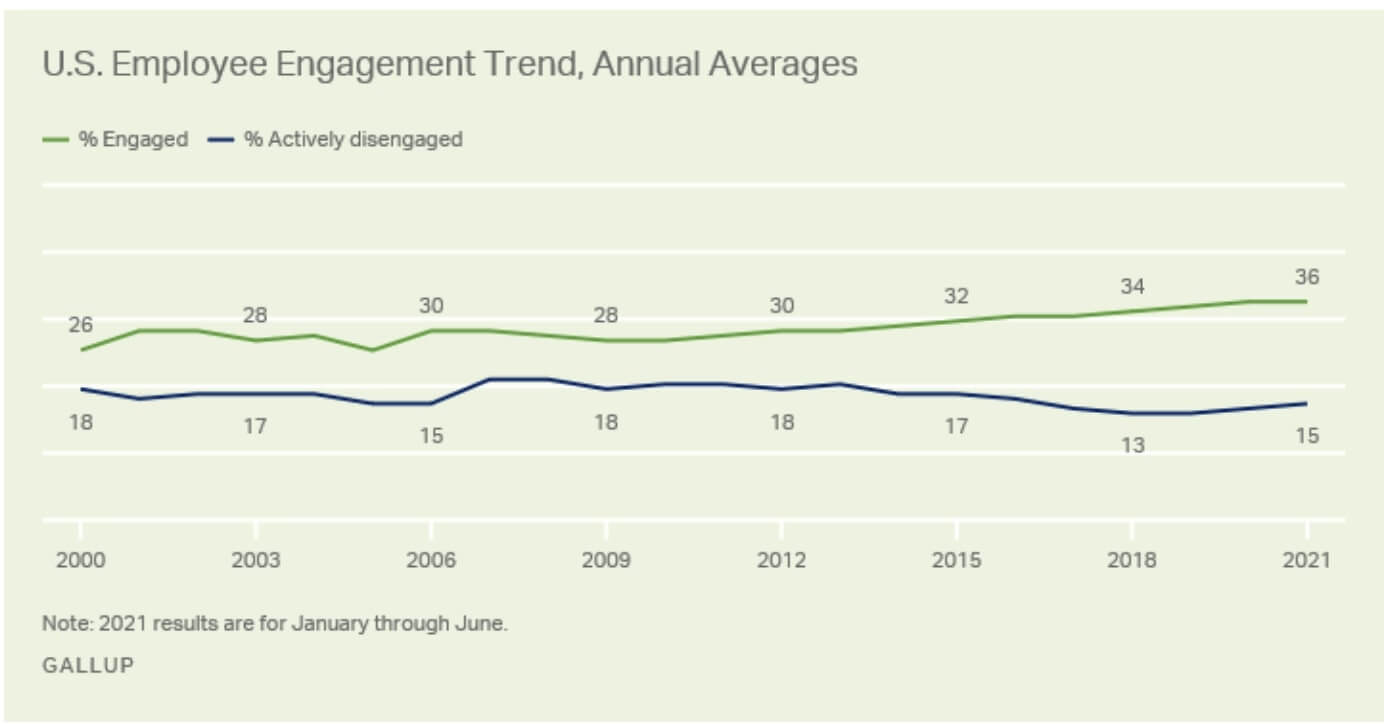
The remaining 49% of workers are in the “disengaged” category – i.e. generally satisfied but not emotionally connected to their work.
As more staff now work remotely following the pandemic, a modern social intranet can increase employee engagement by providing relevant company information, aiding collaboration, sharing ideas, contributing to discussions, and having fun with colleagues.
More productive remote workforce
McKinsey estimates that the average worker spends nearly 20% of the workweek looking for internal information or tracking down colleagues who can help with specific tasks. That’s one day of the week wasted.
With modern intranet solutions, it’s easier for employees to find the tools, resources, and colleagues they need. For example, Federated Search gives users a single interface to find everything they need, resulting in a 35% boost in productivity. Collaborative teams are 5x more efficient than non-collaborative teams, so giving employees the tools necessary to overcome geographic, time-bound, and information barriers is crucial.

“Our onboarding experience has greatly improved thanks to Happeo’s Pages. Instead of having a quick meeting and sending out slides to new employees, we now have an entire Page they can easily refer to.”
Calene Horton
People Operations Manager
Greater employee sastisfaction
All of these factors – improved knowledge management, better Internal Communications, increased employee engagement, and a more productive workforce – lead to greater employee satisfaction.
Modern social intranets provide access to features such as an employee directory, integrated apps, and collaboration tools to make work more intuitive and rewarding.
Happeo as your modern intranet
The modern intranet is the gateway to your digital workplace. It’s the first app employees see when they fire up their web browser or switch on their mobile phone as they work from various locations throughout the day.
It emphasizes social networking and user-generated content and allows employees to participate, interact, and collaborate on various projects and company initiatives.
Moreover, a modern intranet brings many benefits, including:
- Improved knowledge management
- Better Internal Communications
- Increased employee engagement
- More productive remote workforce
- Greater employee satisfaction
Happeo is the modern intranet to help your employees communicate and collaborate and help you grow your business with a happier and more productive workforce.
Want to improve collaboration?
Request a demo today



